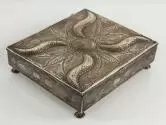New Pieces for the Museum of the American A&C Movement
 This article features excerpts by Jonathan Clancy from Arts & Crafts Metalwork
This article features excerpts by Jonathan Clancy from Arts & Crafts Metalwork
Since the release of its 274 page catalog, Arts And Crafts Metalwork From The Collection Of The Two Red Roses Foundation, authored by David Cathers and Jonathan Clancy, the Foundation has continued to acquire beautiful examples of metalwork to add to its collection. The following objects will be displayed in the forthcoming Museum of the American Arts and Crafts Movement, MAACM, alongside other selections depicted in the book.
This beautifully hand carved and hammered sterling box (top photo), a great example of Navajo work, comes from the estate of Gretchen Osgood (Mrs. Fiske) Warren of Boston, Massachusetts. The Navajo metalsmiths made buckles, bridles, buttons, rings, canteens, hollow beads, earrings, crescent-shaped pendants (called “najas”), bracelets, crosses, powder chargers, tobacco canteens, and disks, known as “conchas” or conchos” – typically used to decorate belts – made from copper, steel, iron, and most commonly, silver.

Early Navajo smiths rocker-engraved, stamped, and filed designs into plain silver, melted from coins, flatware, and ingots obtained from European-American traders. Later, sheet silver and wire acquired from American settlers were also made into jewelry. In 1903, anthropologist Uriah Hollister wrote about the Navajo “Belts and necklaces of silver are their pride… They are so skillful and patient in hammering and shaping that a fairly good-shaped teaspoon is often made of a silver dollar without melting and casting.”
Jessie Preston’s career as metalworker, teacher, and later Red-Cross volunteer, serves as an exemplary model of Arts & Crafts ideals by combining a dedication to handicraft, a belief in the transformative power of craft, and a commitment to education. Preston’s work, like that of many metal workers in the Chicago and Midwestern Arts and Crafts movement, eschewed the more English Gothic elements prevalent among her East Coast contemporaries and reflects the blend of Art Nouveau and Prairie School styles that were emerging in the Midwest. Although her career in the United States lasted only through 1918, her constant participation in exhibitions and broad coverage in local and national media testified to her importance as a metal worker and demonstrates the high regard in which she was held by her contemporaries. View the newly acquired pieces by Jessie Preston here.
Unlike many of his contemporaries who completed varying degrees of professional training that prepared them for a career in the arts, Robert Riddle Jarvie rose quickly from the ranks of amateur hobbyists to become one of the most important metalsmiths of the Arts and Crafts movement. Based in Chicago, in the early years of his career, his nearly singular focus on candlesticks earned him the moniker “the candlestick maker” and won him the respect of fellow craftsmen and critics alike. Indeed, many of Jarvie’s signature candlesticks were noted for the manner in which their designs were consonant with Arts and Crafts Movement ideals about originality, functionality, and aesthetic qualities.
Although Gustav Stickley’s legacy within the history of the Arts and Crafts Movement is well documented, surprisingly little has been written about his contributions to Arts and Crafts metalwork. Yet Stickley, through both the articles he published in The Craftsman and the objects he produced and sold in his retail outlets, served as an important arbiter of taste.
Stickley’s involvement with Arts and Crafts metalwork began somewhat tentatively, despite the attention he paid to the medium in The Craftsman. In May 1902, although he devoted the entire issue to metalwork, he had not established a department to manufacture or sell these wares. Yet, as the magazine acknowledged, this type of work – which one author claimed “offers large opportunities to the craftsman” – was a quintessential expression of the Arts and Crafts for both the worker and the consumer.
The Arts and Crafts movement in America was marked by the spirit of reform and the belief that traditional craftsmanship could ennoble a society overcome by rampant industrialization. Simplicity in style and honesty in construction had the power to transform a utilitarian object into a beautiful one, enhancing the lives of both maker and user.
Arts and Crafts Metalwork showcases the work of eleven designers and craftsmen from the period between 1900 and 1930, including Gustav Stickley, Karl Kipp, Dirk van Erp, and the Roycrofters. Hundreds of color photographs feature more than two hundred metal objects—all selected from the Two Red Roses Foundation’s extensive collection—while archival images of design sketches and magazine advertisements highlight the philosophy and working method behind these artisans and their creations.
For more information and to purchase your copy of Arts & Crafts Metalwork, visit www.tworedroses.com.
Top Photo: Navajo Footed Box with Lid, Hand crafted sterling silver, 6″ square.
Middle Photo: Gustav Stickley Smoking Set, Craftsman Workshops, Eastwood, NY, c. 1910, Hammered Copper, Impressed ‘als ik kan’.
Bottom Photo: Pair of Candlesticks, Robert R. Jarvie, Coppert, c. 1905-1911, 12″ high.

